七年级英语下Unit5教案2 (2)
七年级下册英语Unit 5 Amazing things教案(牛津版)

七年级下册英语Unit 5 Amazing things教案(牛津版)七年级下册英语Unit5Amazingthings教案(牛津版)Unit5AmazingthingswelcometotheunitTeachingaimsknowledgeaims:Attheendofthelesson,thestudentsshould learnsomethingvocabularyaboutUFos,elephants,fishand soon.Abilityaims:Attheendofthelesson,thestudentsshouldle arnhowtotalkaboutsomethingamazingwithsomenewsentenc epatterns.Emotionaims:Attheendofthelesson,thestudentsshouldbe interestedinsomethingamazingaroundthemandhaveanacti veattitudetolife.Importantanddifficultpoints.Theusageof“with”usedasadverbial.2.Thedifferencebetween“stopdoing”and“stoptodo”.TeachingmethodAudio-visualmethod,interactivemethodTeachingaidmultimediacoursewareTeachingproceduresStep1NewwordsLearnsomenewwordsinthislesson.Step2Leadin.Toraisethestudents’interestbysixamazingpictureswithseveralsentencepatt erns.Trytomakethestudentsfamiliarwithsomewordsandst ructures.2.Bywatchingavideo,encouragethemtofinishseveralblanks afterlistening.Step3Exercises.FinishPartA.Lookatthepicturesandmatchthemwiththesentences.Fishsleepwiththeireyesopen.oureyesarethesamesizefrombirth,butournoseandearsnev erstopgrowing.TheSunisabout1,300,000timeslargerthantheEarth.Therearenobonesinthebackofelephants’feet-onlyfat.2.FinishPartB.workinpairsandtalkaboutthistopicwiththewordsinthebo etheconversationbelowasamodel.Step4comicstrip.Askstudentstoanswertwoquestionsbylistening.2.Encouragethemtocompletethedialogueaccordingtothetape.3.Tomakethemunderstanditfullybyretellingthedialogue.Step5Languagepoints.comeon,Eddie.这里comeon是语气词,表示知道某人所说的话不正确,意思是“得了吧”。
人教版2020七年级英语下册 Unit 5 Why do you like pandas教案 (新版)人教新目标版
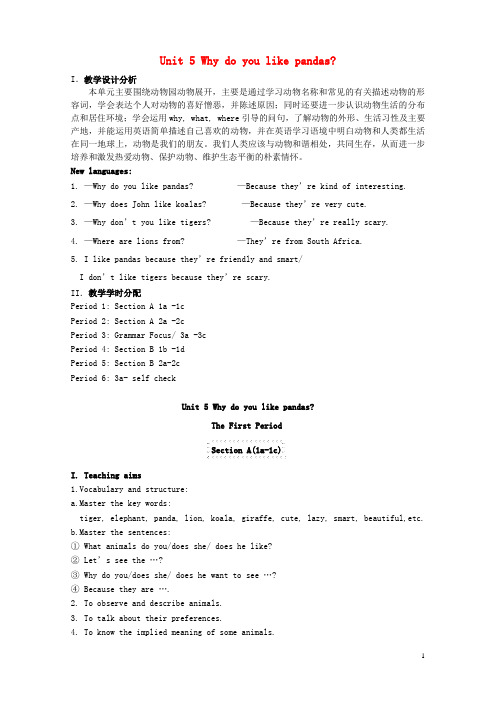
Unit 5 Why do you like pandas?I.教学设计分析本单元主要围绕动物园动物展开,主要是通过学习动物名称和常见的有关描述动物的形容词,学会表达个人对动物的喜好憎恶,并陈述原因;同时还要进一步认识动物生活的分布点和居住环境;学会运用why, what, where引导的问句,了解动物的外形、生活习性及主要产地,并能运用英语简单描述自己喜欢的动物,并在英语学习语境中明白动物和人类都生活在同一地球上,动物是我们的朋友。
我们人类应该与动物和谐相处,共同生存,从而进一步培养和激发热爱动物、保护动物、维护生态平衡的朴素情怀。
New languages:1. —Why do you like pandas? —Because they’re kind of interesting.2. —Why does John like koalas? —Because they’re very cute.3. —Why don’t you like tigers? —Because they’re really scary.4. —Where are lions from? —They’re from South Africa.5. I like pandas because they’re friendly and smart/I don’t like tigers because the y’re scary.II.教学学时分配Period 1: Section A 1a -1cPeriod 2: Section A 2a -2cPeriod 3: Grammar Focus/ 3a -3cPeriod 4: Section B 1b -1dPeriod 5: Section B 2a-2cPeriod 6: 3a- self checkUnit 5 Why do you like pandas?The First PeriodSection A(1a-1c)I. Teaching aims1.Vocabulary and structure:a.Master the key words:tiger, elephant, panda, lion, koala, giraffe, cute, lazy, smart, beautiful,etc.b.Master the sentences:① What animals do you/does she/ does he like?② Let’s see the …?③ Why do you/does she/ does he want to see …?④ Because they are ….2. To observe and describe animals.3. To talk about their preferences.4. To know the implied meaning of some animals.5. Moral aims:We live in the same world with animals, so animals are our good friends. We should get along well with them and protect them.II. Key points1. Help the students to describe animals and talk about animals in right way.2. Express preferences.Difficult point:the plurality of nouns represents a group of things.III. Teaching aidsMultimedia/A tape recorder/A blackboardIV. Teaching proceduresStep 1 Warming-up and lead-inTo create an English environment, the teacher shows the video about animals. And ask some questions:Q1: What is the video about?Q2: Do you like animals?Then have them to recall the animals they had learned and writ e them on the blackboard as he/she can.(e.g. animals---sheep, monkey, cat, dog, mouse, cow, duck… )Step 2 Presentation1.Teach wordsLet’s go to the zoo to see more animals.Then show the class some pictures of animals and present other animals. And ask them: What’s this in E nglish?It's a tiger. (Then lion, panda, elephant, koala, giraffe)Ss look at the picture and try to remember the new words of the animals.2. Next, glue the pictures on the blackboard and ask one student to match the pictures with the words on the cards. Other students turn to page 25 and finish 1a.3. Check the answers with the class.4. Ask them to talk with their partners about the animals they like using the words they know (Four students a group).—What animals do you like?—Why do you like…—Be cause they’re…Step 3 Practice1. ListeningWork on 1b.Tell Ss to listen to the tape and check the animals they hear in 1a.Play the recording again and check the answers with the class.2. Pair work1) Ask the students to imagine “We are in the z oo, there are many kinds of animals here.”Then ask a student to do the model with you:—Let’s see the lions first.—Why? (why do you /does she /does he like lions?)—Because they are interesting.2.) Ss work with their partners practice the conversation using the animal in 1a.Step 4 ConsolidationBased on the language thay learnt in this period, ask Ss to do exercises.Step 5 Summary1. SummaryT: Let’s summarize what we learned in this period. Write the following on the blackboard.—Let’s see the lions first.—Why? (why do you /does she /does he like lions?)—Because they are interesting.2. HomeworkCopy the words 5 times each.V. Blackboard designUnit 5 Why do you like pandas?Section A 1a-1cWords::tiger, elephant, koala, pandas, lion, giraffeSentences:—Let’s see the lions first.—Why? (why do you /does she /does he like lions?)—Because they are interesting.名词的复数形式表示一类事物Teaching reflection:The Second PeriodSection A(2a-2d)I. Teaching aims1.Vocabulary and structure:a.Master the key words: scary, kind, kind of, Australia, south, Africa, South Africa,pet, leg, cat, sleepb.Master the sentences:① Why do you like...?② Because they’re kind of …?③ Why don’t you …?④ Because ….2. To observe and describe animals.3. To talk about their preferences.4. To know the implied meaning of some animals.5. Moral aims:We live in the same world with animals, so animals are our good friends. We should get along well with them and protect them.II. Key points1. Help the students to describe animals and talk about animals in right way.2. Express preferences.Difficult point:the plurality of nouns represents a group of things;the usage of third person singularIII. Teaching aidsMultimedia/A tape recorder/A blackboardIV. Teaching proceduresStep 1 Review1. Game: Can you guess? (animals)Present some descriptions about animals and ask Ss to gues what they are.Step 2 Presentation1. Teach the words (expressions)2. Present the world map and gu ide Ss to think about where are the animals from? Panda— China; Giraffe—Africa; Koala—Australia;Lion—South Africa; Elephant—India3. Listening1) Work on 2a;T: Listen to the conversation carefully. Then write the names of the animals you hear on these lines.Play the recording the first time. Students only listen.Play the recording a second time. This time students write in the names of the animals. Check the answers.Point out the adjectives and countries listed on the right. Ask a student to say the words.Say, Now I will play the recording again. This time draw a line between each animal and the adjective and countries you hear.P lay the recording and have students match each an imal with an adjective and a country. Correct the answers.2) Work on 2bT: Listen again and complete the conversation with the words in 2a.Play the recording for the Ss to listen and write the answers.Check the answers with the class.Step 3 Practice1. Pair work1) Ask two students to read the conversation in 2b to the class.2) Ss practice the conversation in pairs.3) Then show the transcription on the big screen and practice the other two conversations in 2a.4) Ss practice the conversations in pairs.Step 4 Consolidation1. Role-play1) Ask Ss to look at the picture in 2d. Then Ss read the conversation in 2d and find the answers to the questions:① Does Peter have a pet?② What can Dingding do?③ What pet does Jenny’s mom have?④ Does Jenny like the ca t? Why?2) Ss read the conversations and try to find the answers to the questions.3)Check the answers:4)Ss work in pairs and practice the conversation.5) Let some pairs role-play the conversation.2. Language points1) He can walk on two legs.wa lk on… 表示“用某种方式行走”。
牛津译林版七年级下册(新)英语Unit5Reading2教案
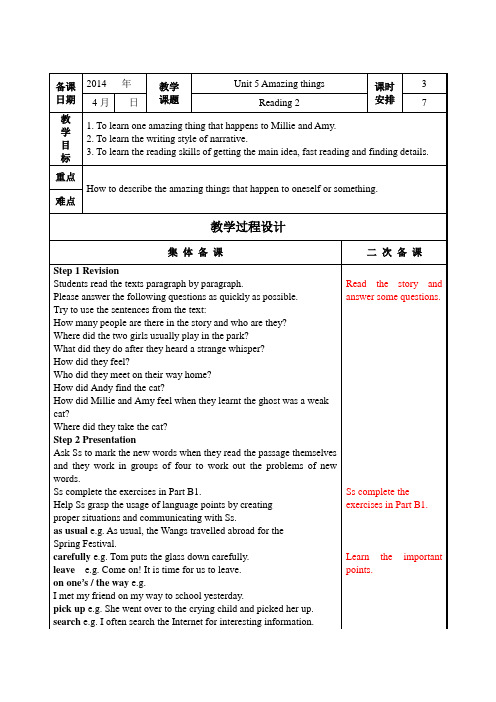
searche.g. I often search the Internet for interesting information.
surprisede.g. My mother looked surprised when I told her the news.
Ss complete the exercises in Part B1.
Help Ss grasp the usage of language points by creating
proper situations and communicating with Ss.
as usuale.g. As usual, the Wangs travelled abroad for the
Spring Festival.
carefullye.g. Tom puts the glass down carefully.
leavee.g. Come on! It is time for us to leave.
on one’s / the waye.g.
I met my friend on my way to school yesterday.
备课
日期
2014年
教学
课题
Unit5 Amazing things
课时
安排
3
4月
日
Reading 2
7
教
学
目
标
1. Tolearn one amazing thing that happens to Millie and Amy.
仁爱版英语七年级下册Unit5_Topic2_SectionC_精品教案

Unit5 Topic2 SectionC 精品教案I. Material analysis本节课是第五单元话题二的第三课时,主要活动是1a、2a和3。
通过阅读描述校园内三个地方正在进行的活动呈现新单词以及匹配、改写句子、现场调查等笔头和口头的活动,复习巩固本话题的语法——现在进行时。
语音部分通过拼读单词音标,并根据字母组合发音规律拼写单词,复习巩固Section A所学音标,训练学生的拼读和拼写能力。
还将通过吟唱小诗,了解句子中单词的连续规则。
本节课的现在进行时涉及到特殊疑问句、一般疑问句以及其肯定和否定回答,教师应该在特定的语境中引导学生大量练习并予以巩固。
II. Teaching aims1.Knowledge aims能根据已学语音、音标及发音规则,正确朗读下列词汇并知其大意,能够准确拼写:around, few, a few, game, sit, ping-pong, lesson, write, aha, blackboard, at the back of, draw, picture在Section A和Section B的语法基础上,能熟练地将“现在进行时”运用于各种人称的特殊疑问句、一般疑问句并进行肯定和否定回答;学生在Section A已学的语音基础上,能结合音标拼写单词,并能尝试结合发音规律拼读新单词。
2.Skill aims能听懂有关谈论正在进行的动作的简单对话或叙述;能根据图文就现在进行的动作等话题进行交流;能够在图片的帮助下读懂体现校园生活的文章,并按要求进行语言活动;能通过观察身边的人用现在进行时描述他们正在进行的活动。
3.Emotional aims能够在谈论校园中正在进行的丰富多彩的活动中,发现校园生活的乐趣,从而培养热爱校园生活、乐于参加学校各种活动的意识。
III. The key points and difficult points1.Key points能熟练地将“现在进行时”运用于各种人称的特殊疑问句、一般疑问句并进行肯定和否定回答。
七年级英语下册Unit5教案

七年级英语下册Unit5教案 A Section A needs 1~2 periods. Section A需用1~2课时。
The main activities are 1a and 2a. 本课重点活动是1a和2a。
Ⅰ. Aims and demands目标要求1. (1)Learn days of the week:Monday, Tuesday, Wednesday, Thursday, Friday(2)Learn subjects:biology, geography, P.E. , art, math, science, history, politics(3)Learn other new words and phrases:today, meeting, outdoor activity, lesson, draw, learn2. Learn Wh-questions.What day is it today?What time does the class begin?3. Talk about subjects and timetables.They are having a music class.—What time is it over?—At a quarter to eleven.Ⅱ. Teaching aids 教具录音机/图片/小黑板/单词卡片Ⅲ. Five-finger Teaching Plan 五指教学方案Step 1 Review 第一步复习(时间:10分钟)通过复习, 导入1a。
1. (师生共同说唱, 复习现在进行时。
)T: Let’s chant“What are you doing?”What are you doing now?I’m singing now.What are you doing now?I’m dancing now.What are you doing now?I’m walking now.What are you doing now?I’m playing now.(一边唱, 一边做动作, 全班学生跟着唱, 一起做动作, 活跃课堂气氛, 激发学生学习兴趣。
人教版新目标七年级英语下册 Unit 5 教案

人教版新目标七年级英语下册 Unit 5 教案一. 教材分析人教版新目标七年级英语下册Unit 5主要讲述了日常生活中的一些活动,如游泳、打篮球、跳舞等。
本单元的话题贴近学生的生活,有利于激发学生的学习兴趣。
教材通过听说读写等多种活动,帮助学生掌握日常生活中的交际用语,提高学生的语言运用能力。
二. 学情分析七年级的学生已经掌握了基本的英语语法和单词,对于日常生活中的交际用语也有了一定的了解。
但部分学生可能在发音和口语表达上还存在困难,需要教师在教学中加以引导和纠正。
此外,学生可能对一些体育活动相关的词汇和表达不够熟悉,需要在课堂上进行拓展和练习。
三. 教学目标1.知识目标:学生能够掌握本单元的生词和短语,了解日常生活中的交际用语。
2.能力目标:学生能够听懂、会说、会读、会写与日常生活相关的英语句子。
3.情感目标:学生能够积极参与课堂活动,提高学习英语的兴趣。
四. 教学重难点1.重点:本单元的生词和短语,日常生活中的交际用语。
2.难点:情态动词can的用法,以及与日常生活相关的句型结构。
五. 教学方法1.任务型教学法:通过设置各种任务,让学生在完成任务的过程中学习英语。
2.情景教学法:创设各种生活情境,让学生在真实的环境中学习英语。
3.交际法:鼓励学生积极参与课堂交际,提高口语表达能力。
六. 教学准备1.准备单词卡片、短语卡片、图片等教学辅助材料。
2.准备与本单元话题相关的视频或音频材料。
3.准备课堂练习题和测试题。
七. 教学过程1.导入(5分钟)利用图片或视频引导学生谈论日常生活中喜欢的活动,引出本课话题。
2.呈现(10分钟)老师展示本课的生词和短语,让学生朗读并解释其意思。
同时,老师用情态动词can提问,引导学生回答。
3.操练(15分钟)学生分角色扮演,用情态动词can进行问答。
老师巡回指导,纠正发音和表达错误。
4.巩固(10分钟)学生完成课堂练习题,老师及时批改和讲解。
5.拓展(5分钟)老师引导学生谈论更多关于日常活动的表达,如游泳、打篮球、跳舞等。
【人教版】新目标七年级下册英语:Unit 5教案
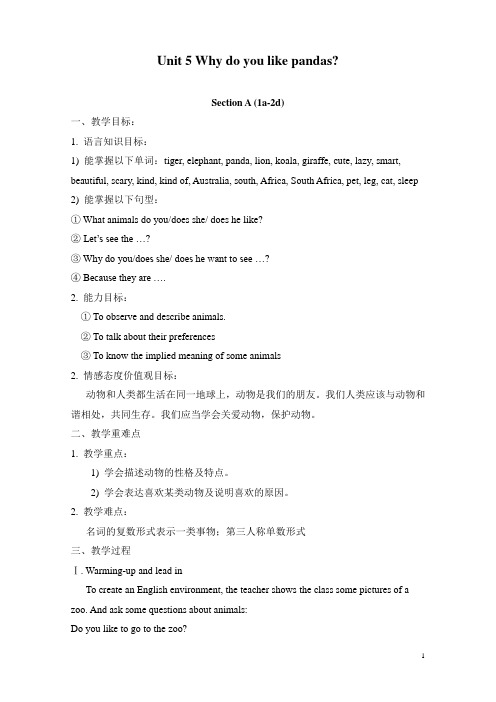
Unit 5 Why do you like pandas?Section A (1a-2d)一、教学目标:1. 语言知识目标:1) 能掌握以下单词:tiger, elephant, panda, lion, koala, giraffe, cute, lazy, smart, beautiful, scary, kind, kind of, Australia, south, Africa, South Africa, pet, leg, cat, sleep2) 能掌握以下句型:① What animals do you/does she/ does he like?②Let’s see the …?③Why do you/does she/ does he want to see …?④Because they are ….2. 能力目标:① To observe and describe animals.② To talk about their preferences③ To know the implied meaning of some animals2. 情感态度价值观目标:动物和人类都生活在同一地球上,动物是我们的朋友。
我们人类应该与动物和谐相处,共同生存。
我们应当学会关爱动物,保护动物。
二、教学重难点1. 教学重点:1) 学会描述动物的性格及特点。
2) 学会表达喜欢某类动物及说明喜欢的原因。
2. 教学难点:名词的复数形式表示一类事物;第三人称单数形式三、教学过程Ⅰ. Warming-up and lead inTo create an English environment, the teacher shows the class some pictures of a zoo. And ask some questions about animals:Do you like to go to the zoo?Do you like animals?Then have them to recall the animals they had learned and write them on the blackboard as he/she can.( e.g. animals,sheep, monkey, cat, dog, mouse, cow, duck… )Ⅱ. Presentation1. Ask them to talk with their partners about the animals they like using the words they know (Four students a group).—What animals do you like?—Why do you like…—Because they’re…2. Then show the class some pictures of animals and present other animals. And ask them:What’s this in English?It's a tiger. (Then lion, panda, elephant, koala, giraffe)Ss look at the picture and try to remember the new words of the animals.3. Next, glue the pictures on the blackboard and ask one student to match the pictures with the words on the cards. Other students turn to page 25 and finish 1a.4. Check the answers with the class.Ⅲ. Game (Guessing game.)T: Show some pictures on the big screen. Let Ss guess what animal it is.Ss try to guess and remember the names of the animals.Ⅳ. ListeningWork on 1b.Tell Ss to listen to the tape and check the animals they hear in 1a.Play the recording again and check the answers with the class.Ⅴ. Pair work1. Ask the students to imagine “ We are in the zoo, there are many kinds of animals here.”Then ask a student to do the model with you:—Let’s see the lions first.—Why? (why do you /does she /does he like lions?)—Because they are interesting.2. Ss work with their partners practice the conversation using the animal in 1a.Ⅵ. Listening1. Work on 2a;T: Listen to the conversation carefully. Then write the names of the animals you hear on these lines.Play the recording the first time. Students only listen.Play the recording a second time. This time students write in the names of the animals. Check the answers.Point out the adjectives and countries listed on the right. Ask a student to say the words. Say, Now I will play the recording again. This time draw a line between each animal and the adjective and countries you hear.Play the recording and have students match each animal with an adjective and a country. Correct the answers.2. Work on 2bT: Listen again and complete the conversation with the words in 2a.Play the recording for the Ss to listen and write the answers.Check the answers with the class.Ⅶ. Pair work1. Ask two students to read the conversation in 2b to the class.2. Ss practice the conversation in pairs.3. Then show the transcription on the big screen and practice the other two conversations in 2a.4. Ss practice the conversations in pairs.Ⅷ. Role-play1. Ask Ss to look at the picture in 2d. Then Ss read the conversation in 2d and find the answers to the questions:① Does Peter have a pet?② What can Dingding do?③What pet does Jenny’s mom have?④ Does Jenny like the cat? Why?2. Ss read the conversations and try to find the answers to the questions.Check the answers:Yes, he does.He can walk on two legs. He can dance, too.She has a cat.No, she doesn’t. Because it’s very lazy.3. Ss work in pairs and practice the conversation.4. Let some pairs role-play the conversation.Homework:1. Remember the new words and expressions in this period.2. Role-play the conversation after class.3. Write the animal's names as many as possible in the exercises book.板书设计:Section A (Grammar Focus-3c)一、教学目标:1. 语言知识目标:1) 继续练习运用如何做描述动物及表述自己对动物的喜好。
仁爱版英语七年级下册:Unit 5 Topic 2-Section B 教案

Section B【教学重难点】1.look for与find的用法:look for意思是“寻找”, 强调“找”的动作。
find是及物动词, 意思是“找到, 发现”, 强调“找”的结果, 后跟宾语。
如:I can’t find my purse. 我找不到钱包了。
Please look for it in your bag. I think you can find it. 请在你的包里找一下, 我想你能找到它。
2.other与else的区别:other修饰名词,位于名词之前。
如:What’s that in your other hand? 你另一只手里拿的是什么?else修饰不定代词、疑问代词或疑问副词,必须位于这些词之后。
如:I have nothing else to say. 我没有其他要说的了。
What else do I need to do? 我还要做其他的什么事情吗?3.The main activities are 1a, 2a and 2b.本课重点活动是1a, 2a和2b。
【教学目标】1.Learn some new words and phrases:borrow, a few, of course, use, look for, shelf, keep, return, on time, pleasure, post, bye-bye, another, Lost and Found, purse, money, else, picture, put on2.Go on learning the present continuous tense.Many students are using them, and they are doing better in English now.I’m looking for my purse.3.Learn how to borrow things.Excuse me, may I borrow a few Ren’ai Project English workbooks?How long can I keep them?You must return them on time.4.Learn how to write Lost and Found.【教学准备】录音机/课件/挂图/图片【教学过程】Step 1 Review 第一步复习(时间:5分钟)复习学校场所, 呈现1a。
人教版七年级英语下册教案(RJ) Unit 5 Why do you like pandas
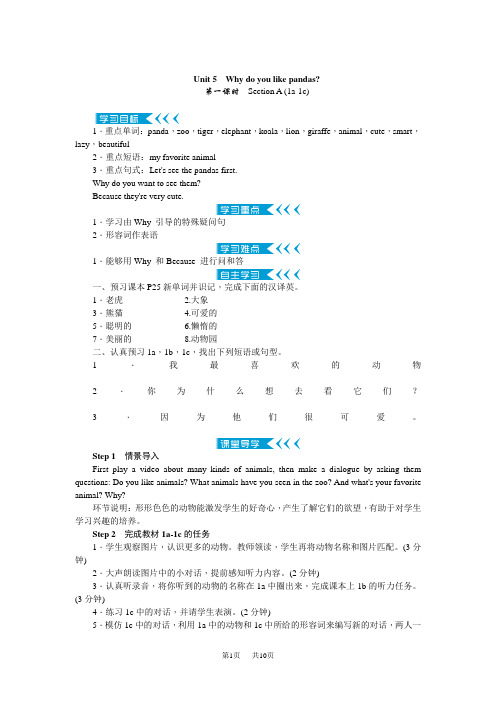
Unit 5Why do you like pandas?第一课时Section A (1a-1c)1.重点单词:panda,zoo,tiger,elephant,koala,lion,giraffe,animal,cute,smart,lazy,beautiful2.重点短语:my favorite animal3.重点句式:Let's see the pandas first.Why do you want to see them?Because they're very cute.1.学习由Why 引导的特殊疑问句2.形容词作表语1.能够用Why 和Because 进行问和答一、预习课本P25新单词并识记,完成下面的汉译英。
1.老虎____________ 2.大象____________3.熊猫____________ 4.可爱的____________5.聪明的__________ 6.懒惰的__________7.美丽的__________8.动物园__________二、认真预习1a,1b,1c,找出下列短语或句型。
1.我最喜欢的动物________________________________________________________________________ 2.你为什么想去看它们?________________________________________________________________________ 3.因为他们很可爱。
________________________________________________________________________Step 1情景导入First play a video about many kinds of animals, then make a dialogue by asking them questions: Do you like animals? What animals have you seen in the zoo? And what's your favorite animal? Why?环节说明:形形色色的动物能激发学生的好奇心,产生了解它们的欲望,有助于对学生学习兴趣的培养。
Unit5Period2课时教案2023-2024学年牛津上海版英语七年级下册
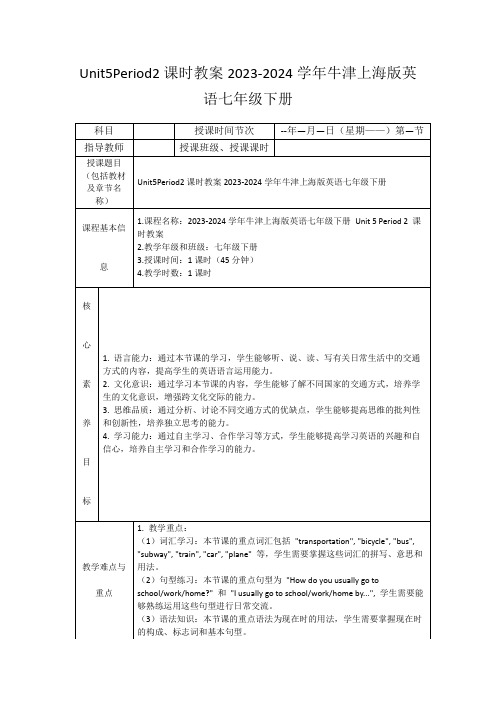
互动探究:
设计小组讨论环节,让学生围绕本节课问题展开讨论,培养学生的合作精神和沟通能力。
鼓励学生提出自己的观点和疑问,引导学生深入思考,拓展思维。
(四)巩固练习(预计用时:5分钟)
随堂练习:
随堂练习题,让学生在课堂上完成,检查学生对知识的掌握情况。
3.思维品质:通过分析、讨论不同交通方式的优缺点,学生能够提高思维的批判性和创新性,培养独立思考的能力。
4.学习能力:通过自主学习、合作学习等方式,学生能够提高学习英语的兴趣和自信心,培养自主学习和合作学习的能力。
教学难点与重点
1.教学重点:
(1)词汇学习:本节课的重点词汇包括"transportation", "bicycle", "bus", "subway", "train", "car", "plane"等,学生需要掌握这些词汇的拼写、意思和用法。
2.设计具体的教学活动:
-角色扮演:学生分组扮演不同交通方式的用户,进行对话练习,提高口语表达能力和听力理解能力。
-听力游戏:设计一个听力游戏,学生通过听到的交通方式词汇进行抢答,增强学生的听力训练和词汇记忆。
-小组讨论:学生分组讨论不同交通方式的优缺点,促进学生的思维品质和批判性思维的发展。
3.确定教学媒体和资源的使用:
激发兴趣:
提出问题或设置悬念,引发学生的好奇心和求知欲,引导学生进入学习状态。
回顾旧知:
简要回顾上节课学习的相关内容,帮助学生建立知识之间的联系。
提出问题,检查学生对旧知的掌握情况,为本节课新课学习打下基础。
Unit5Topic2SectionD教案2023-2024学年仁爱英语七年级下册

八、作业布置与反馈
作业布置:
1. 完成Section D中的练习题,包括选择题、填空题和翻译题,巩固一般现在时的用法。
- 组织学生进行英语演讲比赛或写作比赛,以一般现在时为主题,让学生运用所学的知识进行创作,提高学生的表达能力和创新思维能力。
七、教学反思
今天的课堂氛围总体来说还是很不错的,学生们对于一般现在时的概念和用法有了更深入的理解。在导入新课时,通过提问的方式成功激发了学生的兴趣,让他们迅速进入了学习状态。在讲授新知识时,我尽量用生动的例子和实际情景来解释一般现在时的用法,让学生能够更好地理解和记忆。
2. 句型:一般现在时的特殊疑问句,如"What does he do?","Does she go to school by bus?"等。
3. 对话:Section D中的对话内容,主要描述了两个学生日常的作息习惯。
4. 听力练习:通过听力材料,训练学生对一般现在时的理解和应用。
本节课的教学内容紧密结合学生的日常生活,旨在通过听力、口语、阅读等多种方式,让学生掌握一般现在时的基本用法,提高学生的英语交际能力。
2. 设计一个关于自己日常作息习惯的英文海报,使用一般现在时进行描述。
3. 写一篇短文,描述自己一天中的某个活动,如上学、吃饭、做作业等,使用一般现在时进行叙述。
4. 完成一套英语听力练习题,提高听力理解能力。
作业反馈:
1. 对于Section D中的练习题,我将认真批改学生的答案,指出他们在一般现在时用法上的错误,并提供正确的答案和解释。
七年级英语下册Unit5Whydoyoulikepandas第二课时SectionA(GrammarFocus_3c)教案(新版)人教新目标版

第二课时Section A (Grammar Focus-3c)Target Navigation 【目标导航】Key sentences:(1)—Why do you like pandas?—Because they're kind of interesting.(2)—Where are lions from?—They're from South Africa.Skills:学会谈论动物和掌握where引导的特殊疑问句及其回答。
Emotion:培养学生爱动物的情感。
The guidance of learning methods 【学法指导】采用自主学习的方式,能根据需要进行有目的的预习。
Learning important and difficult points【学习重难点】学会谈论动物和掌握where引导的特殊疑问句及其回答。
Teaching Steps 【教学过程】Autonomous Learning Scheme 【自主学习方案】预习指导与检测(一)预习指导朗读Grammar Focus的句子,总结why和where引导的特殊疑问句的问答规律,然后用why和where造句。
(二)预习检测。
Ⅰ.翻译成英语。
1.种类____________ 2.有几分____________3.南方____________ 4.非洲____________5.睡觉____________ 6.宠物____________(Keys:1.kind,2.kind of,3.south,4,Africa,5.sleep,6.pet)Ⅱ.从方框中选择正确的单词完成下列对话。
very,kind of,koalas,lionsA:Let's see the koalas.B:Why do you like ________?A:Because they're ________ cute.B:Well,I like ________.A:Why do you like lions?B:Because they are ________ interesting.(Keys:koalas,kind of,lions,very)Classroom Learning Guidance Scheme 【课堂导学案】【探究一】Pair work学生结对并大声朗读Grammar Focus中的句子,一问一答,然后交换,直至可相互背诵。
外研版七年级英语下册Module 5 Unit 2 You can buy everything on the Internet.教案

Module 5 Shopping一、学习目标:A.单词和短语:market, supermarket, biscuit, lemon, strawberry, Mother’s Day, size, take, may, try, try on, certainly, wait a minute, sale, price, look, fresh, advantage, anyone, anything, anywhere, compare, pay, post, product, receive, safe, several, online, shopping, way, one of… almost, open, later, out, go out, over, one day, oneB.交际用语:1. Can I help you? / What can I do for you?2. I’d like to buy a T-shirt for my mum.3. — What colour does she like? — Purple.4. — What size does she take? — Small.5. — May I try it on? — Certainly.6. There’s a sale on today. Everything is half price.7. OK! I’ll take it.8. Wait a minute!9. How many / much would you like?C. 教学目标1. Function: Talking about going shopping.2. Structure: Questions: What…? How many / much…?3. Skills: 1) Listening and understanding description..2) Performing a role-play..3) Reading and predicting.4) Transferring information from a table to a passage..4. Around the world: Catalogue shopping.5. Task: Writing a shopping list for a school picnic.二、重点及难点:Questions: What…? How many / much…?三、教学设计:Unit 2 You can buy everything on the Internet.ⅠTeaching modelReading and writing.ⅡTeaching methodTop-down approachⅢTeaching aims1. Listening and understanding description.2. Performing a role-play.3. Reading and predicting.4. Transferring information from a table to a passage.ⅣTeaching ObjectivesKey vocabulary: anyone, anything, anywhere, compare, pay, post, product, receive, safe, several, online, shopping, way, one of… almost, open, later, out, go out, over, one day, oneKey sentence: 1.You can buy almost everything on the Internet, and it’s very easy.2. Then you receive it a few days by post.3. Online shopping has several advantages.4. You can also compare the prices of the same product.5. They can’t see the product or try the clothes on.6. Also paying over the Internet isn’t always safe.7. Online shopping is changing our way of life.8. You’ll be able to buy anything on the InternetⅤTeaching aidsRecorder, OHP, videoⅥTeaching StepsStep 1 Warming-up1. Guessing game.1) Show some pictures.2) According to the information given and ask the students to guess:What colour is it?What size do you take?How much is it?3) Show the pictures to check the answers.2. Review the text of Unit 1.3. Read the words after the teacher.Step 2 Learn new words.1. Show some pictures.2. Talk something about the pictures.3. Introduce the new words.4. Read the words after the teacher.Step 3 Work in pairs.1. Ask the students to read the words in Activity 1.advantage anyone anything anywhere compare2. Look at the title of the passage.3. Think about the questions about online shopping.1) What can you buy?2) How do you pay for it?3) How is it changing our lives?4) Is it good or bad?4. Check their answer with a partner.5. Call back the answer from the whole class and check the answer.Keys:1. I can buy almost everything. Such as clothes, tickets, a mobile phone, and a computer.2. I pay over the Internet.3. We don’t need to go to the shops to buy thing.4. It is good.Step 4 Reading.1. Play the recording and listen to the tape carefully.2. Ask the students to read through the passage.3. Read the passage and check (√ ) the true sentences.1) Online shopping is a new way of shopping.2) You pay for online shopping before you receive it.3) Online shopping is very difficult.4) It’s very safe to shop over the Internet.5) Our way of life is changing because of online shopping.4. Check with a partner.5. Call back the answers from the whole class.Keys: 1. √ 2. √ 3. ×4. ×5. √6. Read the text together.Step 5 Complete the passage.2. Ask the students to read through the passage in Activity3.Internet shopping is easy. You buy something online, you (1) __________for it, then a few days (2)_________ you (3) ___________ it by post. But going (4) __________ and shopping with friends is much more fun !3. Complete the passage with the words from the box.4. Check with a partner.5. Call back the answers from the whole class.Keys: 1. pay 2. later 3. receive 4. out6. Read the passage together.Step 6 Work in pairs.3. Check with a partner.4. Call back the answers from the whole class.Keys:Advantages: quick easy can buy almost everything…Disadvantages: can’t see things first not safe to pay over the Internetless fun …Step 7 Writing.1. Ask the students to write sentences describing the advantages with first and second.First, you can shop at any time…Second,…2. Check with a partner.3. Call back the answers from the whole class.Keys:First, you can shop at any time. The shops are always open. Second, shopping usually takes a lot of time. But to shop on the Internet you only need a computer and a mouse! You can also compare the prices of the same product and spend a lot…or save money.4. Now write sentences describing the disadvantages. Introduce the first disadvantages with but.But many people like going out…5. Check with a partner.6. Call back the answers from the whole class.Keys:But many people like going out and shopping with friends. They don’t like shopping on the Internet because they can’t see the product or try the clothes on. Also paying over the Internet isn’t always safe.Step 8 Do exercises:一、翻译下列短语:1.网购__________________2.几乎所有的东西__________________3.在网上__________________4.选择一些东西__________________5.支付__________________6.几天__________________7.通过邮递__________________ 8.几个缺点__________________9.在任何时候__________________ 10.花费一些时间__________________11.对比…的价格__________________ 12.同样的产品__________________13.花钱__________________ 14.节约钱__________________15.喜欢外出__________________ 16.试穿衣服__________________17.网上支付__________________ 18.改变生活方式__________________19.不再__________________ 20.能够__________________Keys:1. online shopping2. almost everything3. on the Internet4. choose something5. pay for6. a few days7. by post8. several advantages9. at any time 10. take a lot of time 11. compare the prices of 12. the same product 13. spend a lot14. save money 15. like going out 16. try the clothes on 17. paying over the Internet 18. change one’s way of life 19. not… any more 20. be able to二、完成句子:1. 网购是一种新的购物方式。
七年级英语下册 Module 5 Unit 2 You can buy everything on the Internet教案
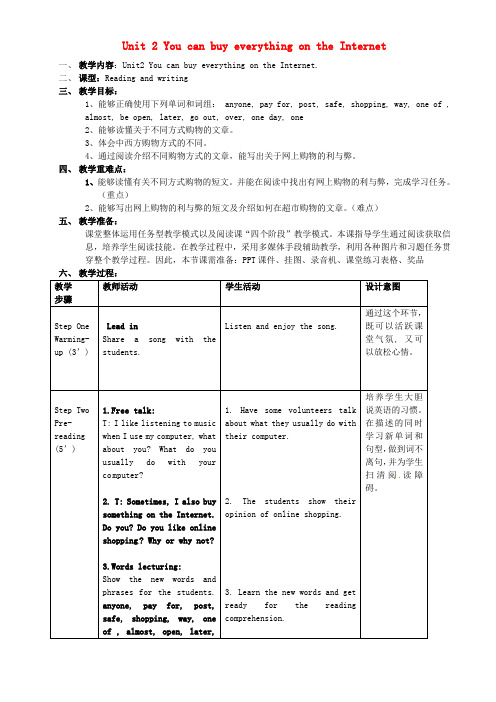
Unit 2 You can buy everything on the Internet一、教学内容:Unit2 You can buy everything on the Internet.二、课型:Reading and writing三、教学目标:1、能够正确使用下列单词和词组: anyone, pay for, post, safe, shopping, way, one of ,almost, be open, later, go out, over, one day, one2、能够读懂关于不同方式购物的文章。
3、体会中西方购物方式的不同。
4、通过阅读介绍不同购物方式的文章,能写出关于网上购物的利与弊。
四、教学重难点:1、能够读懂有关不同方式购物的短文。
并能在阅读中找出有网上购物的利与弊,完成学习任务。
(重点)2、能够写出网上购物的利与弊的短文及介绍如何在超市购物的文章。
(难点)五、教学准备:课堂整体运用任务型教学模式以及阅读课“四个阶段”教学模式。
本课指导学生通过阅读获取信息,培养学生阅读技能。
在教学过程中,采用多媒体手段辅助教学,利用各种图片和习题任务贯穿整个教学过程。
因此,本节课需准备:PPT课件、挂图、录音机、课堂练习表格、奖品mputer?? Why or why not?it.have debateon Page 29.is 2.To choo s e the best groups.七、板书设计:Module 3. ShoppingUnit 2. You can buy everything on the Internet.anyone / anything / anywhere First, you can shop at any time.compare… Also paying over the Internet isn’t always safe. pay for… not…any more / no longer /no more receive…from sb. be able to / cansafeone of + n.(pl) + V.(s)达标训练题一、翻译下列短语:1、…其中之一______________2、付款__________________________3、在任何时候_____________4、花费大量的时间________________5、省钱____________________6、网上购物______________________7、几天后__________________ 8、外出________________________二、用所给词的适当形式填空:1. There are many ways of ___________(learn) English well.2. You can go shopping when the supermarket is ___________(open).3. Many ____________ (people) like going our and shopping with friends..4. Shopping usually ____________ (take) a lot of time.5. There _________(be) something new on the newspaper today.。
牛津译林版英语七年级下册 Unit 5 Amazing things 教案(2)
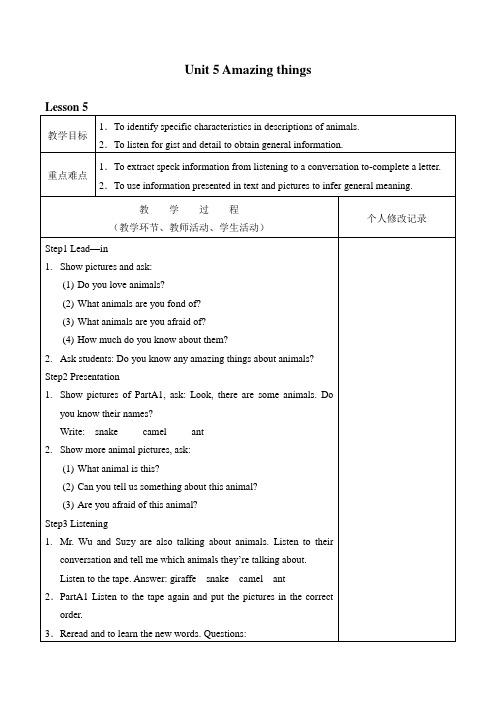
Chalk
The artist is drawing a 3-D picture with chalk/It’s really amazing.
2.The students are talking about amazing things in the world.Listen to
the tape and answer the following questions. 1)How did the young man travel around over 80 countries? (By
教学过程 (教学环节、教师活动、学生活动)
个人修改记录
Step1 Lead—in 1. Show pictures and ask:
(1) Do you love animals? (2) What animals are you fond of? (3) What animals are you afraid of? (4) How much do you know about them? 2. Ask students: Do you know any amazing things about animals? Step2 Presentation 1. Show pictures of PartA1, ask: Look, there are some animals. Do you know their names? Write: snake camel ant 2. Show more animal pictures, ask: (1) What animal is this? (2) Can you tell us something about this animal? (3) Are you afraid of this animal? Step3 Listening 1. Mr. Wu and Suzy are also talking about animals. Listen to their conversation and tell me which animals they’re talking about. Listen to the tape. Answer: giraffe snake camel ant 2.PartA1 Listen to the tape again and put the pictures in the correct order. 3.Reread and to learn the new words. Questions:
人教版新目标七年级英语下unit5教案

七年级英语(下)第5单元第1课时
Unit 5 Why do you like pandas?
Section A 1a—2d
一、【教材分析】
二、【教学流程】
三、【板书设计】
四、【教后反思】
七年级英语(下)第5单元第2课时
Unit 5 Why do you like pandas?
Section A 3a—3c
一、【教材分析】
二、【教学流程】
三、【板书设计】
四、【教后反思】
七年级英语(下)第5单元第3课时
Unit 5 Why do you like pandas?
Section B 1a—1d
一、【教材分析】
二、【教学流程】
三、【板书设计】
四、【教后反思】
七年级英语(下)第5单元第4课时
Unit 5 Why do you like pandas?
Section B 2a—3b
一、【教材分析】
三、【板书设计】
四、【教后反思】
2022年4月25日七年级英语(下)第5单元第5课时
Unit 5 Why do you like pandas?
Self Check
一、【教材分析】
三、【板书设计】
四、【教后反思】。
牛津译林版英语七年级下册Unit5 Integrated skills精品教案
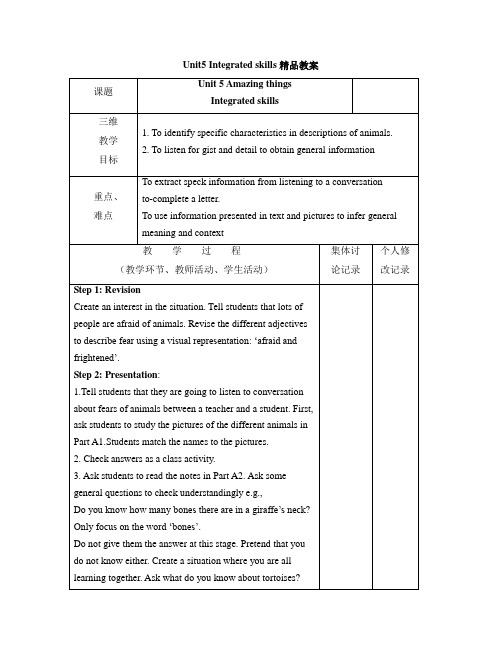
1.Tell students that they are going to listen to conversation about fears of animals between a teacher and a student. First, ask students to study the pictures of the different animals in Part A1.Students match the names to the pictures.
6.Ask students tread Suzy’s letter in Part A3. Ask them to complete the letter from the information they have already identified in the previous listening and the notes they have made.
教学过程
(教学环节、教师活动、学生活动)
集体讨
论记录
个人修改记录
7. Play the recording again and ask students to check their answers.
8.Divide the class into pairs and ten students to read the letter. Students compare and check each other’s choice of nouns. Encourage students to work out whether their choice of nouns makes sense.
2. Check answers as a class activity.
2020-2021译林牛津版初中英语七年级下Unit 5 第2课时Reading教学案

7B Unit 5 Amazing things (第2课时)Reading问题导学单教学目标To learn to guess meanings of new words from the context To learn to skim text for overall meanings and scan for details To understand the structure of difficult sentences教学重点To learn to guess meanings of new words from the contextTo learn to skim text for overall meanings and scan for details教学难点To understand the structure of difficult sentences【温故知新】一、词汇。
1. There are many trees and in the garden(bush).2. I was to hear that he didn’t pass the exam.(surprise)3. He said to , ”I must study hard.”(he)4. It is for him to buy each of us a present today. What happened?(usual)5. Take .The bus may hit you if you are not or you don’t look .(care)6. The baby is sleeping. Don’t make any and you go to ask them not to jump up and down , because it is too now.(noise)7. There's only _______ (脂肪) in the back of elephants' feet.8. He is sitting on the__________ (背部) of the giraffe. Can you take a photo of him?9 --How is your little brother? -- He is deaf(聋子). He can't hear anything from _______ (出生).10. There are no_________ (骨头) in the back of elephants' feet.【预习导航】一、完成句子1.你知道他昨天发生什么事情了吗?Do you know yesterday?2. Simon 仔细地寻找,但是没有发现什么奇怪的事情。
冀教版七年级英语下册Unit5全单元教案
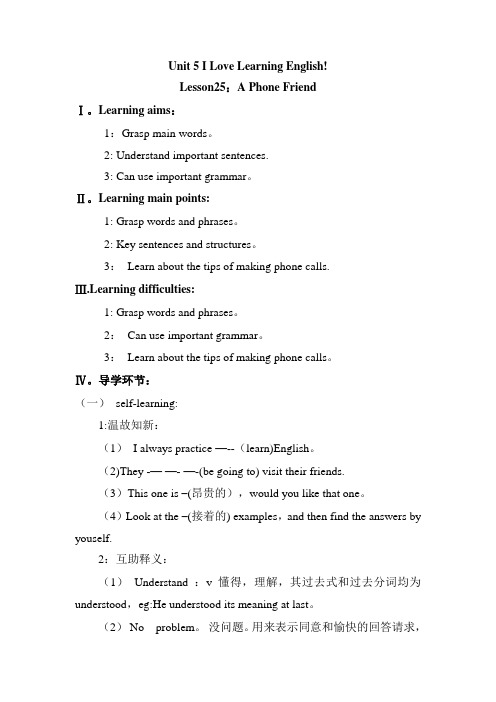
Unit 5 I Love Learning English!Lesson25:A Phone FriendⅠ。
Learning aims:1:Grasp main words。
2: Understand important sentences.3: Can use important grammar。
Ⅱ。
Learning main points:1: Grasp words and phrases。
2: Key sentences and structures。
3:Learn about the tips of making phone calls.Ⅲ.Learning difficulties:1: Grasp words and phrases。
2:Can use important grammar。
3:Learn about the tips of making phone calls。
Ⅳ。
导学环节:(一)self-learning:1:温故知新:(1)I always practice —--(learn)English。
(2)They -——- —-(be going to) visit their friends.(3)This one is –(昂贵的),would you like that one。
(4)Look at the –(接着的) examples,and then find the answers by youself.2:互助释义:(1)Understand :v 懂得,理解,其过去式和过去分词均为understood,eg:He understood its meaning at last。
(2)No problem。
没问题。
用来表示同意和愉快的回答请求,也可回答感谢,意为“不客气”eg:——-Thank you --——No problem。
(3)Could 的用法:could 用作情态动词,意为“能;可能”是can的过去式,(1)用来表示过去的能力:She could swim when she was six。
译林版英语七年级下学期unit5全单元教案
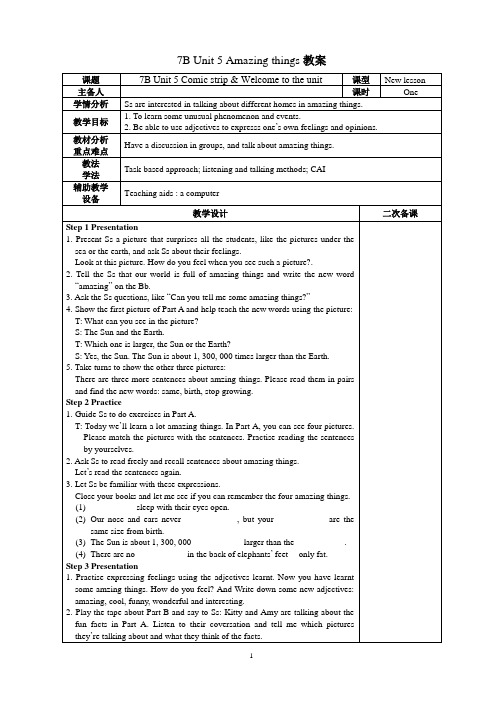
1. Guide Ss to do exercises in Part A.
T: Today we’ll learn a lot amazing things. In Part A, you can see four pictures. Please match the pictures with the sentences. Practise reading the sentences by yourselves.
(1)__________ sleep with their eyes open.
(2)Our nose and ears never ____________, but your ___________ are the same size from birth.
(3)The Sun is about 1, 300, 000 ___________ larger than the ___________.
2.There are many ghosts in Chinese history. You must have read some, right> Do you want to read a modern ghost story?
3.Today we’ll read a ghost story. Turn to page 58. Pay attention to the caption and the picture. Can you tell me where the story happens and who might see a“ghost’?
(4)There are no ___________ in the back of elephants’feet--- only fat.
- 1、下载文档前请自行甄别文档内容的完整性,平台不提供额外的编辑、内容补充、找答案等附加服务。
- 2、"仅部分预览"的文档,不可在线预览部分如存在完整性等问题,可反馈申请退款(可完整预览的文档不适用该条件!)。
- 3、如文档侵犯您的权益,请联系客服反馈,我们会尽快为您处理(人工客服工作时间:9:00-18:30)。
七年级英语下Unit5教案2Section B needs1period.Section B需用1课时。
The main activities are1,2and3a.本课重点活动是1,2和3a。
Ⅰ.Aims and demands目标要求1.(1)Learn adverbs of frequency:seldom,never,sometimes(2)Learn other new words and phrases:weekday,early,bird,catch,walk,ride,park,watch TV,do(one’s)homework2.Learn the simple present tense.I always get up at about six o’clock.I often go to school by bike.3.Practice adverbs of frequency.(1)I seldom walk to school.I never go to school by bike.(2)—How does Maria go home?—She sometimes goes home by subway./She sometimes takes the subway home.Ⅱ.Teaching aids教具录音机/图片Ⅲ.Five-finger Teaching Plan五指教学方案Step1Review第一步复习(时间:10分钟)通过选择方案一或方案二复习交通方式导出1,并呈现2。
1.(方案一:单词竞赛。
)T:Boys and girls,let’s have a word competition as usual.When I speak Chinese,please say them in English accordingly.Row1,begin!boat,ship,train,plane,usually,always,early,on foot,by plane,by subway(方案二:利用头脑风暴法,在1分钟内,让每组每名学生依次说出一种乘坐的交通工具,看哪组学生说的又多又正确,就获胜。
)T:Now each group has one minute.Each of you says one kind of transportation.The group that can say the most will win.2.(链式发问。
每竖排第一个学生问其后第二个学生一个问题,第二个回答并接着问第三个,以此类推。
每组2分钟时间。
问题是:How do you usually go to school?/Do you often go to school by bus/car…?)Example:S1:How do you usually go to school?S2:I usually go to school by bike.How do you usually go to school?S3:I usually go to school by bus.Do you often go to school by car?S4:Yes,I do.But sometimes I go to school by bus.…3.(根据第2个环节的实际情况,老师总结并导出对话1的语言功能目标,为下一步过渡做铺垫。
)T:Good.Now I know some of you go to school by bike,and some go to school by bus.I always get up at about six o’clock.I often go to school on foot.But sometimes I go to school by bike.I never go to school by bus.4.(板书2的图,然后用每个频度副词和表示交通工具的词造句。
)Step2Presentation第二步呈现(时间:5分钟)呈现1。
1.(通过了解学生的起床时间,引出谚语The early bird catches the worm.让学生猜出这句谚语的意思。
)T:What time do you usually get up?S1:I usually get up at half past six.S2:…T:We should go to bed early and get up early.As the saying goes,“The early bird catches the worm.”Who knows the meaning of this sentence?(让学生猜测,教师板书并加以讲解。
)2.(根据1的主要信息,设置听力任务,让学生带着任务听1的录音,可以提高兴趣降低难度。
)T:Listen to1and find out the answers to these questions on the blackboard.(板书问题并以英汉对照的形式板书生词。
)weekday平日,walk步行,never从来没有(1)What time does Michael get up onweekdays?(2)How does Michael usually go to school?(3)Does Kangkang often go to school bysubway?(4)Who always takes a bus to school?3.(让学生再听一遍1的录音并核对答案。
)Step3Consolidation第三步巩固(时间:10分钟)巩固1和2的内容。
1.(放1的录音,让学生跟读,用铅笔标出重读与语调。
)T:Follow the tape and mark the stress and intonation with your pencil.2.(让学生擦去所标重读与语调,先自读,然后跟录音一起读,逐句核对语音语调。
这样做可以使学生集中注意力,效率更高。
)T:Erase your marks,and read by yourselves.Now,read after the tape and check your pronunciation and intonation.Ready?Go!3.(人机对话,即学生和录音机对话。
这样能提高学生的兴趣。
)T:OK.Suppose you were Michael and Jane.Listen to the tape and make a dialog with Kangkang.4.(在黑板上呈现关键词,让学生利用关键词造句。
)(板书)never,seldom,sometimes,often,usually,alwaysExample:T:never:I never go to school on foot.5.(根据上面板书的关键词让学生一问一答,进行对话。
)T:Work in pairs,and close your books.Look at the key words on the blackboard and make similar dialogs.Step4Practice第四步练习(时间:10分钟)呈现3a的图片完成3b,练习2,呈现同义替换,完成4。
1.(1)(呈现3a的图片,通过师生互动,让学生进一步了解和巩固语言知识。
)T:Look at the first picture.How does Maria go home?Ss:She takes the subway.(通过谈论第2、3、4幅图,可以得到以下几个句子。
)Example:Li Xiang comes to school by bike.We go to the park on foot.They go to the zoo by bus.(2)(让学生听3a的录音,记录其中的主要信息。
如人物、频度副词及乘坐的交通工具。
)T:Listen to the tape and write down the sentences you hear on your exercise books.Example:Maria sometimes goes home by subway.Li Xiang often comes to school by bike.We usually go to the park on foot.They always go to the zoo by bus.(3)(核对答案。
)T:Now let’s check the answers together.2.(1)(让学生完成3b。
)T:Now,talk about the pictures in3a with your partner.Example:S1:How does Maria go home?S2:She sometimes goes home by subway.Is that clear?Begin!(2)(呈现句子的同义替换,加强对交通工具方式的灵活运用。
总结并板书。
)by subway —take the subwayby bike —ride a bike on foot —walkby bus —take a bus by car —take a car by plane —flyT:Look at this sentence again:She sometimes goes home by subway.We can also say:She sometimes takes the subway home.But what about these sentences?⎪⎩⎪⎨⎧bus.by zoo the to go always They foot.on park the to go usually We bike.by school to goes often Xiang Li (3)(让学生做上一步的同义替换练习,核对并板书答案。
)Answers:Li Xiang often rides a bike toschool.We usually walk to the park.They always take a bus to the zoo.3.(播放4的录音,让学生完成4并核对答案。
)Step 5Project 第五步综合探究活动(时间:10分钟)利用所学交通工具词汇和频度副词进行实践活动。
